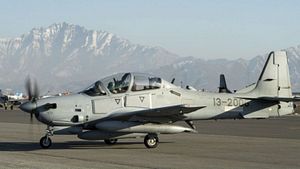The Pentagon has ordered six additional Embraer/Sierra Nevada Corporation A-29 Super Tucano light attack aircraft for the Afghan Air Force (AAF), Brazilian aircraft maker Embraer Defense & Security announced in an October 25 press release.
“Production of these six new aircraft is to start immediately in Jacksonville, Florida and brings to 26 the total number of aircraft provided to the Program,” the statement reads. The U.S. Air Force has spent a total of $427 million under its so-called Light Air Support/A-29 Afghanistan Program to supply the AAF with 20 A-29 aircraft by the end of 2018. Each Super Tucano cost around $18 million.
The press release did not state a delivery date for the new A-29 Super Tucano aircraft.
The latest batch of four A-29s arrived in Afghanistan at the end of March bringing the total number of A-29 light attack aircraft currently in service with the AAF to 12. The remaining seven aircraft are stationed at Moody Air Force Base in Georgia for pilot training and will be transferred to Afghanistan in the coming months. (One aircraft crashed during a training exercise and has yet to be replaced.)
Thirty AAF pilots and 90 ground staff including maintenance crews are currently undergoing training at Moody Air Force Base. According to an August 2017 U.S. Air Force press release, up until now “17 pilots and 48 maintainers have been trained and have returned to Afghanistan.” Given the six additional A-29s ordered this week, nine more pilots and 20 maintainers will need to be trained. The training program is expected to continue until the end of 2020.
This week, the Special Inspector General for Afghanistan Reconstruction (SIGAR) revealed in a new report that 50 percent of all foreign military personnel that went AWOL (“Absent Without Leave”) while undergoing training in the U.S. since 2005 were from Afghanistan. This has also included AAF personnel. A celebrated Afghan female pilot refused to return to Afghanistan following the completion of her training last December.
As I reported previously, the U.S. Air Force’s A-29 Super Tucano program has encountered repeated delays since its inception (See: “Confirmed: First Four A-29 Light Attack Aircraft Arrive in Afghanistan”):
Brazilian aircraft maker Embraer and its U.S. partner Sierra Nevada Corporation where initially awarded the contract to supply 20 A-29 light attack aircraft in 2011. However, the contract was cancelled in 2012 due to a dissatisfaction of USAF leadership “with the quality of the documentation supporting the award decision.” However, the contract was re-awarded to Embraer and Sierra Nevada Corporation in 2013.
U.S. military officers repeatedly refer to the A-29 aircraft as a “game changer” for the Afghan National Defense and Security Forces on the battlefield. However, it is difficult to independently verify its impact during the ongoing fighting season.
The light attack aircraft can be armed with conventional or smart free-fall bombs, short-range air-to-air missiles, machine guns and rockets. “However, it is still unclear whether the AAF’s A-29s have the capability for surgical airstrikes,” I explained in March. “The aircraft has been specifically designed for counterinsurgency campaigns, and is relatively cheap to operate (one hour of flying time costs around $1,000).”































